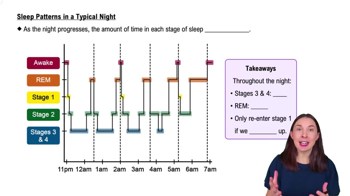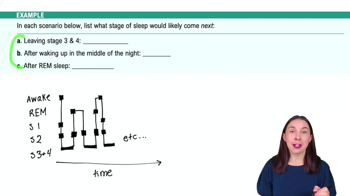Table of contents
- 1. Introduction to Psychology1h 43m
- 2. Psychology Research2h 20m
- 3. Biological Psychology2h 41m
- 4. Sensation and Perception28m
- 5. Consciousness and Sleep32m
- 6. Learning41m
- 7. Memory34m
- 8. Cognition37m
- 9. Emotion and Motivation35m
- 10. Developmental Psychology33m
- 11. Personality48m
- 12. Social Psychology41m
- 13. Stress and Health41m
- 14. Psychological Disorders44m
- 15. Treatment47m
5. Consciousness and Sleep
Sleep
Struggling with Psychology?
Join thousands of students who trust us to help them ace their exams!Watch the first videoMultiple Choice
Clay told his therapist about a dream he had in which he was flying on an airplane, but he was unaware of his destination. Clay's therapist explained that the flying in his dream, in its latent context, represents freedom and independence from his parents and the unknown destination exemplifies a sense of fear and doubt from no longer having parents as guides. Clay's therapist appears to be using _____ to explain his dream.
A
the activation-synthesis hypothesis
B
a Freudian psychoanalytic interpretation
C
the activation-information-mode model
D
Hall's interpretation of dreams
 Verified step by step guidance
Verified step by step guidance1
Identify the key elements of the dream: flying on an airplane and being unaware of the destination.
Understand the latent content of the dream: flying represents freedom and independence, while the unknown destination signifies fear and doubt.
Recognize that the therapist is interpreting the dream by analyzing its symbolic meanings, which is a characteristic of Freudian psychoanalysis.
Freudian psychoanalysis involves exploring the unconscious mind and interpreting dreams to uncover hidden desires and emotions.
Conclude that the therapist is using a Freudian psychoanalytic interpretation to explain Clay's dream, as it focuses on the symbolic meanings and latent content.

 3:25m
3:25mWatch next
Master Circadian Rhythms with a bite sized video explanation from Hannah Gordils
Start learningRelated Videos
Related Practice


































































































![Race, Genes and IQ Differences | Bret Weinstein [Mini Clip]](https://img.youtube.com/vi/IztL_m3pd70/mqdefault.jpg)



































































































